How do you best Store Fiber?
I love getting questions about posts or fiber arts, so if you think of any feel free to post them in the comments sections and I will get you an answer, but it might take me a while…
I was asked about the best ways to store fiber for long term, and I thought I would share what I have compiled!
Thanks for asking! Most of the fibers that you buy are fine being left in the bags that you bought them in. My overflowing stash at home has many fibers that are still in the bags I bought them in, for the most part this is not a problem. However, there are some fibers that shouldn’t be stored in plastic for a long period of time, think over a year, and some fibers are processed in a way that can condense down so the fibers become more difficult but not impossible to spin if stored under pressure.
Ideally all of your fiber is going to be stored with plenty of room wrapped in tissue paper, or in pillowcases, that are then inside of plastic bins that seal… but you open once a month to air out, with a natural moth deterrent inside.
For most of us this is never going to be our reality, so we adopt as many of these good habit as we can without interfering with our spinning time.
Here are some rough guideline about storing your spinning fibers.
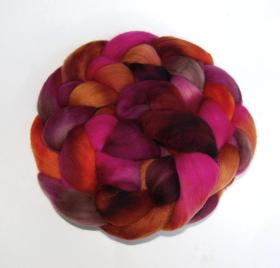
Wool is remarkably elastic it will rebound from being crammed into small containers well, however the finer fibers don’t always recover as well as others depending on how they are processed.
- Fibers that are “carded only” have greater loft then combed top, and when they are compressed they become less ordered and you lose some of the fiber characteristics showcased with the style of processing.
- Combed top has fibers aligned as close as possible this then allows for the fibers to compress even further together. This can make different styles of spinning more difficult.
Storing wool in plastic bags can lead to felting or matting. If you have your fiber in a bag and you aren’t constantly handling the bags there is less of a chance for matting or felting, but if you’re moving your fiber ever couple of days in their plastic bags you can have a few different outcomes.
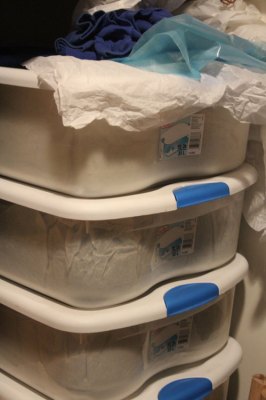
Felting happens when moisture and heat cause the scales of wool to open and then agitation locks the scales together. When pressure in a sealed environment is added to the mix, less moisture, heat or agitation is required, but felting will occur over time with the natural temperature changes in the air. Unless your bags are vacuum sealed having wool by a plastic bag can lead to more felting
Ideally fibers should be stored so that they don’t rub, or move against the plastic bags, if you wrap your fiber in tissue paper then seal them in a plastic bag you’ll avoid most of your problems. The paper will absorb excess moisture and insulate your fiber from the matting/static elements of plastic.
Why not plastic bags? You’ll often hear that wool should be stored in sealed plastic to prevent the moths, which does work well. Sealing fibers does help to keep fibers safe from moths, but your fiber doesn’t need to rub against the plastic, nor do you have to seal fiber to keep it safe.
Fibers that should Never be stored in plastic bags under pressure:
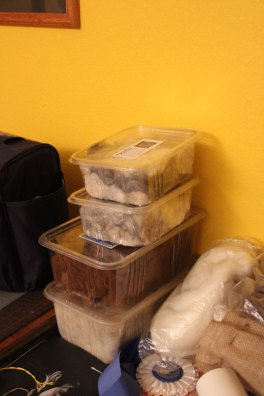
Unwashed fiber/damp fiber- it will rot! Unwashed fiber has the salts and sweats of the animal on it, skirted fleeces should be stored in cloth bags until they are washed and ready to come inside.
Angora rabbit – This fiber will matt! Rabbits suffer from matting on the body and the fiber under pressure in plastic can lead to matting as well. Furthermore, plastic can lead to static electricity building up making so when you attempt to spin the fibers they actively attempt to evade you. If a little moisture is trapped inside it can lead to larger issues with pests. Store your angora in a paper bag, or loose and non-compressed in a container lined with tissue paper.
Dog or Cat hair: Most likely if you are collecting fiber to make a unique gift or item out of dog or cat it has not been properly cleaned before you start stuffing it way. You might have just washed your dog and collected the hair, but it is still not clean! Hair can hold a surprising amount of dirt and moisture that can lead to smell, mold and pests. Don’t store this fiber with your stash unless you know it has been well cleaned. Dog and cat hair should be stored in fabric or paper containers to prevent matting or molding.

Moths: If you are looking for a solution to sealed containers your can always try some of the natural moth deterrents, aka, smelly things! Moths avoid lavender, rosemary, clove, mint, and cedar. You can make your own moth balls with cotton balls with a few drops of essential oils of smells above, or sachets filled with herbal elements or cedar chips. Some people also use small blocks or chunks of cedar at the bottom of your bag.
Stay away from mothballs! The chemicals in mothballs can permanently embed into the fibers, changing the smell of you fibers and sometimes causing an allergic reaction. The chemicals are known carcinogens and can melt plastic leaving fibers coated in plastic goo.
Above are all of the big points about storing fiber- If I missed something you wanted to know about Please let me know so I can add to it. .
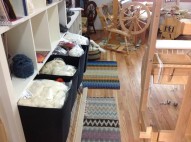
I wish we could all have lovely fiber storage like Priscilla but if you are not as organized as her don’t feel bad…. below is mine
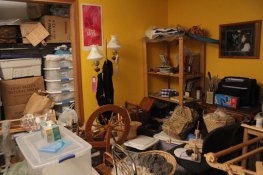
Regardless of you system or organizational habits I hope you get the most of your fibers and enjoy them- after all why else did you take up this hobby? If you have any questions or comments I would love to hear them! But for now I have some organization to do…
